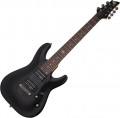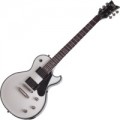Number of strings
The number of strings provided in the design of the guitar. The meaning of this parameter depends on the type of instrument (see above).
The most common by far is the Spanish (
six-string) tuning; accordingly, most electric guitars and semi-acoustic instruments have exactly 6 strings. A smaller number is practically never found, but a larger one may well be used — models are produced for
7 and even 8 strings. Usually, they belong to the class of so-called baritone guitar, which is a transitional option between a conventional electric guitar and bass. The main 6 strings in "baritones" are tuned slightly lower than usual, and in addition to them, one or two more bass strings are installed. In combination with the increased length of the scale, this allows to achieve a richer and denser sound; it is especially appreciated by performers of heavy styles of music like death metal, although it can also be used in less "extreme" genres.
As for bass guitars, they have a standard number of strings —
4, and "extended" models have
5, occasionally —
6 strings. At the same time, unlike guitars, additional strings in basses are designed not to lower, but to increase the range. Using additional "raised" strings is often much more convenient than clamping the high frets.
Pickups
Type of pickups used in electric guitar.
—
Passive. Passive pickups are called pickups that do not use their own power supply. Such devices produce a weak signal, so guitars with passive pickups require an external preamp. In terms of sound, many musicians consider passive pickups to be more "natural" and dynamic, but this point is largely subjective. The unequivocal advantage of this option is the extensive features for experimenting with the technique of sound extraction. In addition, passive modules are much simpler and cheaper than active modules, and they do not require their own power supplies. On the other hand, these pickups are subject to feedback, which can be problematic in some situations. Yes, and sensitivity to pickups (and, accordingly, the likelihood of interference) they are significantly higher.
—
Active. Pickups supplemented with built-in preamps to increase the level of the signal fed to the output of the instrument. Thanks to the additional amplification, many models have fewer coil turns than passive models, which reduces interference and provides a cleaner and more balanced signal. At the same time, the active module retains the upper frequencies better; this gives the effect of "brightness", "transparency" of the sound. However there is an opinion that this sound turns out to be unnatural, but this moment, again, is largely subjective. But from the unequivocal disad
...vantages of active pickups, one can note the need for their own power source. One of the most popular options for this is a 9V battery, which is installed in a special compartment in the body of the guitar.Coil cutoff
The ability
to disable one of the coils in a humbucking pickup.
Pickups with this feature are, in fact, universal modules that can operate in both humbucking and single-coil modes. See "Pickup Diagram" for details on both. And the ability to switch between these modes allows the musician to change the colour of the sound without resorting to external gadgets or changing instruments. For example, for a dynamic composition with rich overdrive, it is more convenient to use a classic humbucker, and for a slow, lyrical melody, just move the switch and you can enjoy all the advantages of a single-coil.
Type
The type of tone block used in the construction of an electric guitar.
A timbre block is an “intermediary” between a pickup and a guitar output: a set of electronic circuits that provides signal transmission, and often also its processing (volume control, frequency correction, preamplification, etc.). In modern electric guitars, there are such types of tone blocks:
— Passive. Passive are called timbre blocks that do not require additional power sources during operation. Usually, such modules have the simplest design and functionality, adjustments are limited to changing the volume, as well as passively correcting frequencies (by “cutting off” the desired frequencies). At the same time, passive tone blocks are simple, compact, inexpensive and do not depend on batteries; and the necessary adjustments can be made on external equipment (anyway, the electric guitar will need to be connected to it). As a result, most modern instruments are equipped with this particular type of tone blocks.
—
Active. The key difference between a passive tone block is that it needs its own power source to work. Most often, this role is played by a PP3-type battery installed in a special socket in the body of an electric guitar. The need for power is due to the abundance of additional functions: active tone blocks are able to amplify the signal coming from the pickups, suppress interference, and even match the output impedance of the inst
...rument with the input of the amplifier. Yes, and the active method of tone control is more advanced than the passive one, it allows you to more accurately adjust the frequency ratio. On the other hand, active modules are noticeably more expensive, and without a battery, the tone block turns into a set of useless parts. However, such devices consume relatively little energy, and one battery lasts for quite a long time.
— Active/passive. Tone blocks that combine the capabilities of the two options described above. If there is power, such a module operates in active mode, and if there is no power, it turns into passive. Thus, the musician can enjoy all the advantages of the active tone block and at the same time not worry that the instrument will become completely useless due to a dead battery (although, of course, the tone block functionality is not so extensive in the passive mode). At the same time, combined modules are quite complex and expensive, and the real need for such versatility is rare. Therefore, this option has not received much distribution.Volume controls
The number of volume controls provided in an electric guitar.
If there is only one knob, this means that the musician can only adjust the overall volume of the instrument. However, there are models that have several volume control knobs — usually there are no less of them than pickups (2 or 3), which allows you to separately adjust the volume of each pickup. And since the characteristics of the sound depend on the type of the used pickup (see "Pickup Diagram") and even its location, then by changing the mutual volume of the individual pickups, you can achieve different coloring of the sound. At the same time, the design may also include a general volume control, which allows you to adjust it in the classical way and not mess with the settings of each pickup.
Shape
The general shape of the body of an electric guitar.
The solid body of an electric guitar can be molded into almost any shape; hollow cases do not give such freedom, however, even among them, the options in shape can be very diverse. However, there are certain standard forms. It is not uncommon for these shapes to be named after a particular "legendary" guitar model, such as the "Les Paul" or "Stratocaster" (after Gibson and Fender instruments of the same name, respectively). It makes no sense to describe each standard form — it's easier to find an illustration in our catalog or on the Internet.
The main, and often the only point, which is affected by the shape of the body is the appearance of the guitar. Also, convenience for the musician to some extent depends on this parameter — for example, some models allow you to play while sitting, resting the instrument on your foot, for others this method is weak or not suitable at all. But whether the shape of the body affects the sound of an electric guitar is a moot point. There is an unequivocal dependence only in semi-acoustic models, but for solid bodies there is no clear answer to this question: some musicians claim the superiority of some forms over others, but this moment is largely subjective. In addition, other parameters (types and number of pickups, bridge design, etc.) greatly affect the sound quality.
Now on the market there are guitars with this body shape:
Les Paul,
Superstrat,
Stratocaster,
Jazz Bass,
Precision Bass,
Telecaster,
PRS Santana,
Flying V,
SG, however, there are also completely
non-standard options.
Cutaway
A type of cutout provided in the construction of a guitar body.
The notch is located at the point where the neck is attached to the body and can be
single or
double. The single cutout for a standard guitar hold is on the bottom, under the neck. It is designed to allow the player to comfortably use the higher (closer to the bridge) frets without the body getting in the way of the left hand (or right, in a left-handed instrument). In models with a double cutout, there is also a notch above the neck, it may be smaller than the bottom one. The top notch is provided mainly for aesthetic purposes, to give the instrument a distinctive appearance, but it can also be useful in fact — for example, if the player uses his thumb to hold the frets.
Note that some variants of the body shape do not provide cutouts at all — this is simply not required. Flying B body guitars are an example.
Pickguard
The presence of a protective lining (pickguard) on the body of the guitar.
Such an overlay is located on the upper deck, most often made of durable plastic and differs markedly in colour, due to which it is clearly visible. Its main purpose is to protect the soundboard surface from pick strikes (for example, when playing with dynamic fighting), which could damage the varnished wooden surface. The specific shape and size of the fingerboard may vary, but anyway, it covers at least the surface below the strings (when looking at the guitar in the working position), and sometimes under the strings and even above them.
Material
The material from which the body of an electric guitar is made. For models with cutouts (semi-acoustic, see "Type"), in this case, only the material of the back deck and sides can be taken into account, and data on the top deck is given separately (for more details, see "Deck Cover Material").
Now on the market there are cases of such trees:
red,
maple,
agatis,
ash,
alder.
It makes no sense to dwell on each of the materials found in modern electric guitars. Their variety is very large, however, unlike acoustic guitars, the body in this case does not play such a significant role in shaping the sound, and its material has a relatively small effect on the acoustic properties of the instrument (although the exact degree of such influence is a moot point). If you wish, you can find detailed data on a particular material in special sources, but in fact it makes sense to look primarily at the appearance of the instrument and its price category.

